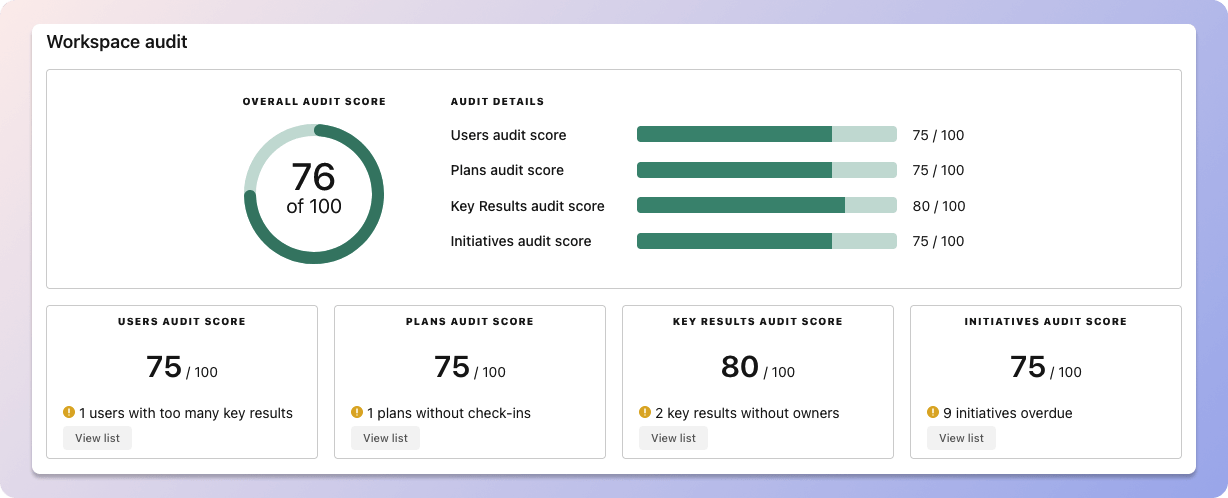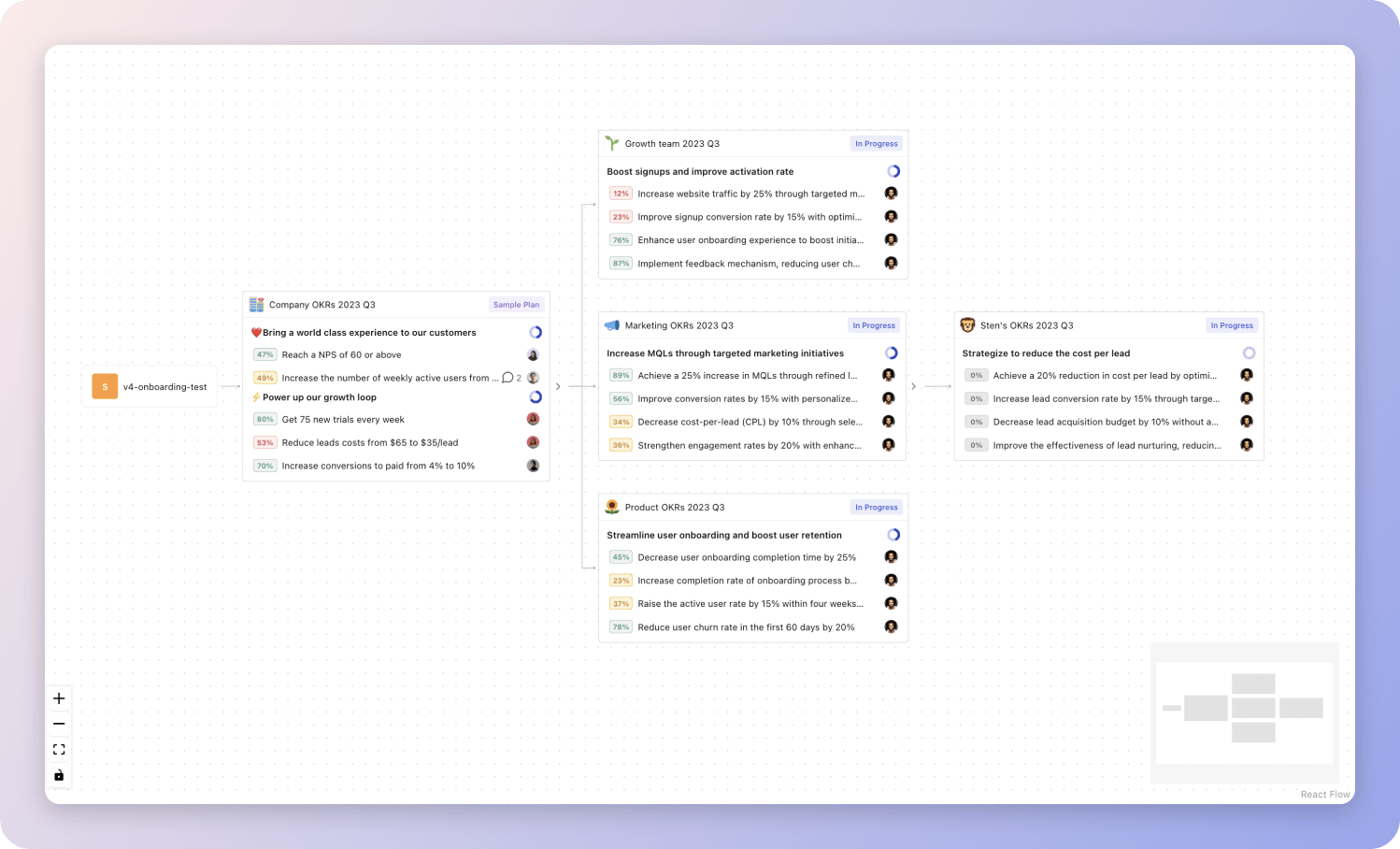8 customisable OKR examples for Systems Administrator
What are Systems Administrator OKRs?
The Objective and Key Results (OKR) framework is a simple goal-setting methodology that was introduced at Intel by Andy Grove in the 70s. It became popular after John Doerr introduced it to Google in the 90s, and it's now used by teams of all sizes to set and track ambitious goals at scale.
How you write your OKRs can make a huge difference on the impact that your team will have at the end of the quarter. But, it's not always easy to write a quarterly plan that focuses on outcomes instead of projects.
That's why we have created a list of OKRs examples for Systems Administrator to help. You can use any of the templates below as a starting point to write your own goals.
If you want to learn more about the framework, you can read our OKR guide online.
Building your own Systems Administrator OKRs with AI
While we have some examples available, it's likely that you'll have specific scenarios that aren't covered here. You can use our free AI generator below or our more complete goal-setting system to generate your own OKRs.
Feel free to explore our tools:
- Use our free OKR generator
- Use Tability, a complete platform to set and track OKRs and initiatives, including a GPT-4 powered goal generator
Our customisable Systems Administrator OKRs examples
We've added many examples of Systems Administrator Objectives and Key Results, but we did not stop there. Understanding the difference between OKRs and projects is important, so we also added examples of strategic initiatives that relate to the OKRs.
Hope you'll find this helpful!
1. OKRs to successful Exchange and Migration of Server Systems
Successful Exchange and Migration of Server Systems
Conduct a thorough inventory and categorize all existing servers by end of Week 1
Complete inventory by end of Week 1
Compile a comprehensive list of all existing servers
Categorize servers based on their function
Migrate 50% of identified servers without causing any system downtime by Week 6
Execute migration plan during off-peak hours to avoid downtime
Identify non-essential servers for initial migration to minimize potential impact
Develop and test migration strategy for selected servers
Complete the migration and ensure all systems are fully functional and optimized by Week 12
Conduct thorough testing on all systems
Optimize system functionality by Week 12
Finish the migration process by Week 12
2. OKRs to consolidate and streamline server infrastructure
Consolidate and streamline server infrastructure
Create comprehensive upgrade plan for remaining servers
Analyze necessary improvements for each server
Identify all servers that require an upgrade
Sketch a detailed upgrade timeline
Implement updated server technology in 40% of systems
Identify the systems suitable for updated server technology
Commence 40% system upgrade with updated server technology
Prepare servers for technology upgrades in chosen systems
Reduce active servers by 15% without impacting performance
Execute server consolidation without affecting user experience
Identify least-occupied servers and potential consolidation opportunities
Monitor server performance regularly post-consolidation
3. OKRs to optimize ManageEngine for efficient patching and software deployment
Optimize ManageEngine for efficient patching and software deployment
Increase software deployment success rate on ManageEngine by 30%
Implement comprehensive pre-deployment testing procedures
Conduct regular team training on deployment best practices
Enhance error handling and recovery mechanisms
Decrease patch implementation errors on ManageEngine by 25%
Implement comprehensive patch testing before deployment
Enhance staff training regarding ManageEngine
Review and refine existing patch management processes
Improve ManageEngine's deployment time by reducing it by 20%
Implement automated deployment tools to streamline the process
Optimize current scripts for quicker software deployment
Continually monitor and fine-tune deployment mechanisms
4. OKRs to improve Access control, management, and automation efforts
Improve Access control, management, and automation efforts
Decrease access control approval cycle time by 15% with efficient automation application
Measure and adjust automation efficiency to hit the 15% reduction target
Identify bottlenecks in the current access control approval process
Implement an automation software to streamline approval tasks
Implement automation in 2 new critical systems, preparing for 1 click deployment
Test one-click deployment and resolve issues
Develop automation scripts for the identified systems
Identify two critical systems suitable for automation
Reduce manual intervention in access management processes by 20% using automation
Monitor system regularly to ensure automated processes are working efficiently
Train staff on utilizing automation features for access management
Implement automated access management software in the system
5. OKRs to successfully migrate virtual machines from Linux 7 to Linux 8
Successfully migrate virtual machines from Linux 7 to Linux 8
Complete 100% migration with zero post-migration issues within 60 days
Allocate resources for pre and post-migration testing
Ensure end-user training for new system adaptations
Develop a comprehensive migration plan with clear deadlines
Identify and document all potential compatibility issues by end of week 2
Review all systems and software for potential compatibility issues
Finalize and submit issue documentation by end of week 2
Document identified compatibility problems with detailed descriptions
Successfully move and test 50% of all virtual machines inside 30 days
Conduct thorough testing on moved virtual machines
Identify and catalog all virtual machines for relocation
Execute the migration process for 50% of cataloged systems
6. OKRs to maintain up-to-date security patches on our infrastructure
Maintain up-to-date security patches on our infrastructure
Assess and catalog current state of security patches within two weeks
Create a comprehensive catalog of findings
Identify all systems and software requiring security updates
Verify and document the existing security patches
Implement 100% of identified necessary security updates by quarter's end
Develop and execute a schedule for updates
Complete and verify each security update
Identify all required security updates
Develop and initiate routine weekly checks to confirm security patch updates
Establish routine checks for these updates
Identify necessary security patches weekly
Implement and confirm successful patch updates
7. OKRs to decommission all identified systems by 2024
Decommission all identified systems by 2024
Conduct final review to ensure all decommissioned systems are properly shut down
Document final review findings
Confirm cessation of systems via verification protocols
Identify all systems slated for decommission
Successfully decommission 50% of identified systems by end of quarter
Execute decommissioning safely and efficiently
Identify essential vs. non-essential systems for business operations
Develop a detailed decommissioning plan and schedule
Complete inventory of all systems slated for decommission by end of quarter
Finalize and document inventory report
Conduct thorough inventory of these systems
Identify all systems scheduled for decommissioning
8. OKRs to successfully migrate admin application to existing platform
Successfully migrate admin application to existing platform
Train all users on the new platform to ensure smooth transition
Monitor user experience for further improvements
Develop comprehensive training materials on the new platform
Organize training sessions for all users
Complete data migration without any loss or errors
Perform a full backup of all existing data
Verify and validate migrated data
Use reliable software to conduct data migration
Update all functionalities to align with existing platform requirements
Identify and note necessary updates for functionalities
Review current platform requirements thoroughly
Implement and test functionality updates
Systems Administrator OKR best practices to boost success
Generally speaking, your objectives should be ambitious yet achievable, and your key results should be measurable and time-bound (using the SMART framework can be helpful). It is also recommended to list strategic initiatives under your key results, as it'll help you avoid the common mistake of listing projects in your KRs.
Here are a couple of best practices extracted from our OKR implementation guide 👇
Tip #1: Limit the number of key results
The #1 role of OKRs is to help you and your team focus on what really matters. Business-as-usual activities will still be happening, but you do not need to track your entire roadmap in the OKRs.
We recommend having 3-4 objectives, and 3-4 key results per objective. A platform like Tability can run audits on your data to help you identify the plans that have too many goals.
 Tability's audit dashboard will highlight opportunities to improve OKRs
Tability's audit dashboard will highlight opportunities to improve OKRsTip #2: Commit to weekly OKR check-ins
Don't fall into the set-and-forget trap. It is important to adopt a weekly check-in process to get the full value of your OKRs and make your strategy agile – otherwise this is nothing more than a reporting exercise.
Being able to see trends for your key results will also keep yourself honest.
 Tability's check-ins will save you hours and increase transparency
Tability's check-ins will save you hours and increase transparencyTip #3: No more than 2 yellow statuses in a row
Yes, this is another tip for goal-tracking instead of goal-setting (but you'll get plenty of OKR examples above). But, once you have your goals defined, it will be your ability to keep the right sense of urgency that will make the difference.
As a rule of thumb, it's best to avoid having more than 2 yellow/at risk statuses in a row.
Make a call on the 3rd update. You should be either back on track, or off track. This sounds harsh but it's the best way to signal risks early enough to fix things.
How to turn your Systems Administrator OKRs in a strategy map
The rules of OKRs are simple. Quarterly OKRs should be tracked weekly, and yearly OKRs should be tracked monthly. Reviewing progress periodically has several advantages:
- It brings the goals back to the top of the mind
- It will highlight poorly set OKRs
- It will surface execution risks
- It improves transparency and accountability
Most teams should start with a spreadsheet if they're using OKRs for the first time. Then, once you get comfortable you can graduate to a proper OKRs-tracking tool.
 Tability's Strategy Map makes it easy to see all your org's OKRs
Tability's Strategy Map makes it easy to see all your org's OKRsIf you're not yet set on a tool, you can check out the 5 best OKR tracking templates guide to find the best way to monitor progress during the quarter.
More Systems Administrator OKR templates
We have more templates to help you draft your team goals and OKRs.
OKRs to successfully transition from monolith to microservices architecture
OKRs to implement a new CMS successfully
OKRs to improve invoice processing and payment efficiency
OKRs to enhance overall company profitability
OKRs to build a comprehensive new customer CRM database
OKRs to enhance my soft skills competency
OKRs resources
Here are a list of resources to help you adopt the Objectives and Key Results framework.
- To learn: What is the meaning of OKRs
- Blog posts: ODT Blog
- Success metrics: KPIs examples
Create more examples in our app
You can use Tability to create OKRs with AI – and keep yourself accountable 👀
Tability is a unique goal-tracking platform built to save hours at work and help teams stay on top of their goals.
 1 Create your workspace
1 Create your workspace 2 Build plans in seconds with AI
2 Build plans in seconds with AI 3Track your progress
3Track your progress